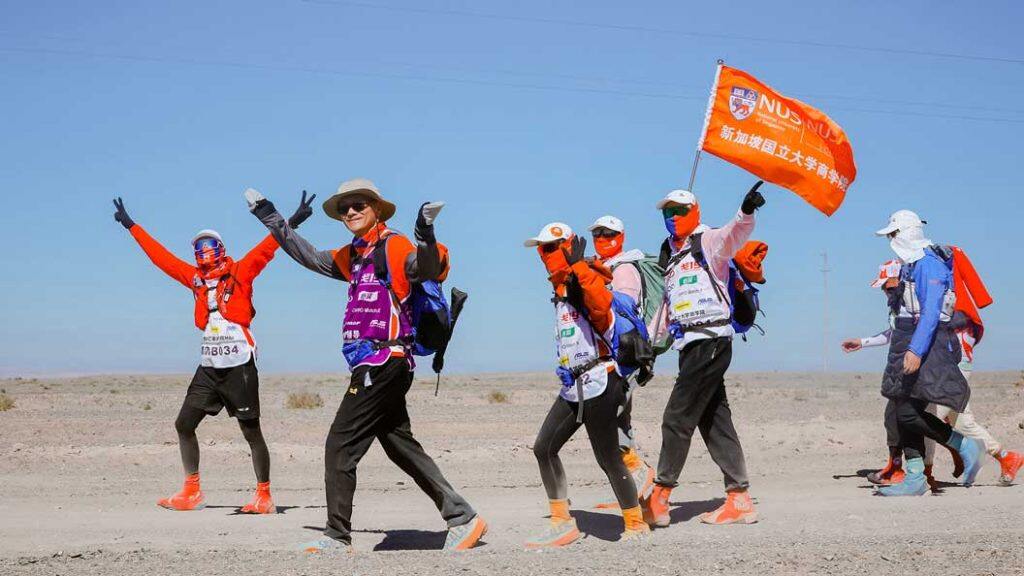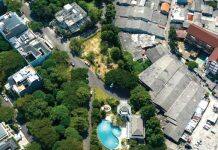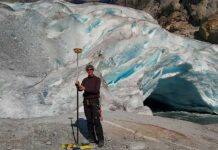

By Professor Tan Eng Chye
The formidable Gobi Desert is the perfect classroom in the wild, a fertile ground for self-discovery and transformation.
A 121 km trek through its harsh and punishing terrain is nothing short of a herculean task, not least due to the extreme temperatures that drop to lows of minus 6 degrees Celsius at night, then climb to highs of 29 degrees Celsius in the day. This autumnal weather – amid which I and a team of NUS EMBA students and alumni trekked, over four days and three nights – is in fact milder than the other seasons of the mercurial desert, but no less daunting.
Forget about stopping to smell the roses; we were preoccupied with our survival and crossing the finishing line. We wore shoe covers to prevent sand from causing blisters, changed our socks twice a day to remove any sand that seeped in, and donned compression tights to reduce muscle fatigue. All this while lugging three litres of water on our backs, with the unrelenting sun beating down on us.
We were finally rewarded with a breathtaking view during the last 5 km of our journey – an oasis in the wilderness. But any sense of reprieve was short-lived, as the shimmering waterhole that captivated us had to be trudged through too.
The annual Gobi Desert Challenge pays tribute to the fortitude of Xuanzang, a Chinese Buddhist monk who undertook a similar journey to India more than 1,300 years ago. Today, it is a test of endurance and teamwork for top Asian business schools with Chinese Executive MBA programmes, with over 50 institutions participating this year. This was my fifth time embarking on the trek, but it was immensely rewarding and I still learnt new lessons.
The first was the importance of training and preparation. To understand, respect and embrace nature is to not underestimate it. The beauty of the desert lies in its harshness – while there were a few wild animals around, for most of the trek we were surrounded by a beautiful – but unforgiving – landscape of undulating hills, volcanic pebbles, salt beds, and hot desert sand. Even with modern technology and equipment, the journey remained challenging. We gained a profound respect for people of the past who faced these hardships head-on without such resources.
The second lesson was the value of teamwork, grit and resilience. In the face of nature, we are miniscule against the vast expanse – however accomplished we might be in our professional day jobs. It is not every day that the CEO of Gong Cha Singapore or the Senior Principal of Furen International School are your trekking companions. Kang Puay Seng and Li Wei are veterans in their 60s who have participated in this challenge before, but wanted to prove they still possessed the tenacity to see it through. I could relate to that, as I wanted to test my limits after my partial knee replacement last February.
While completing the trek might have been the main objective, there was a secondary goal: to ensure that all your teammates made it out safely. This required a keen understanding of team dynamics, including identifying those who needed extra support. We always had designated “sweep teams”, made up of more experienced team members whose responsibility was to ensure that no one was left behind. They took on the strenuous task of shuttling between parts of the trek to assist those who were trailing due to blisters or muscle cramps, and to clear the route ahead of any obstacles. Less experienced trekkers were also grouped with stronger teammates, paying homage to the adage that we are only as strong as the weakest link.
Third, and most importantly, the unpredictability of the natural elements, from sudden temperature fluctuations to shifting terrains, mirrors the realities of our world. We live in a volatile, uncertain, complex and ambiguous environment today, and more than ever do we need agility, adaptability and innovation to effectively navigate challenges.
We may not have to battle a literal sandstorm in our everyday lives, but the same principles apply when it comes to responding to unexpected challenges, be it rapid technological disruptions or environmental crises.
I believe that skills like situational awareness, teamwork and discipline are best taught and learnt outside the classroom – something our students understand well. In many ways, the Gobi Desert Challenge aligns perfectly with NUS’ commitment to experiential education, which aims to cultivate well-rounded, resilient and culturally sensitive individuals who can thrive not just during but beyond their time at NUS.
Everywhere is a classroom
Not all students possess the natural drive and determination to learn independently. From the time we enter primary school, learning is dictated by a fixed curriculum. Teachers speak, students listen.
But experiential learning has sparked a significant shift in mindset. It is learning by doing, not just passively absorbing. Rather than educators mandating what should be learnt, students are given the opportunity to take charge of their own learning by stepping outside the classroom and engaging with real-world problems. It is a matter of triggering their interest. Once that is achieved, people will learn independently, and they will learn deeply.
Pre-COVID, the Gobi Desert Challenge was compulsory for our EMBA students. Although this requirement has since been lifted, the event has remained an important part of the cultural fabric of the NUS Business School. In fact, the enthusiasm has only ramped up. This year’s contingent is the University’s largest since it first participated in the challenge in 2007, surpassing 100 members for the first time.
This comes as no surprise. In recent years, experiential learning has become part of the DNA of our MBA programme. It is why students are inducted into the programme through a five-day boot camp called “Launch Your Transformation” which aims to hone crucial leadership skills through a series of activities and discussions.
This approach is not just bespoke to the business school. Spontaneous and self-inspired learning is an institution-wide philosophy. NUSOne, NUS’ latest initiative launched this year, complements our rigorous interdisciplinary education by providing more ground-up avenues to participate in student life and out-of-classroom experiences, encouraging greater self-directed growth among students in a free-ranging and organic way.
For instance, Wednesday afternoons are now mostly free from classes, allowing students to develop their interests outside the classroom, whether it be volunteering or participating in a wide range of co-curricular activities.
This is based on the fundamental belief that student life is an essential part of an education. Our students do not just go out to work; they should be well-rounded, active and responsible global citizens who can make a change in their communities.
Experiential learning is a necessary facet of higher education, and one that resonates closely with NUS’ mission to educate, inspire and transform. Transformation is a passage for the bold and willing – it can be nudged in the right direction but the motivation must come from within. Our job as institutes of higher learning is to awaken and fuel that motivation.
Next year, NUS celebrates its 120th anniversary. I have encouraged my EMBA students to convince their entire cohort to participate in the 20th edition of the Gobi Desert Challenge in 2025. As leaders in their own right, their biggest challenge lies in their personal evolution. With my background in mathematics, I cannot help but see the meaning in numbers – 120 years, 121 km, a shot to redefine yourself.
Professor Tan Eng Chye is President of the National University of Singapore and a mathematician.







































